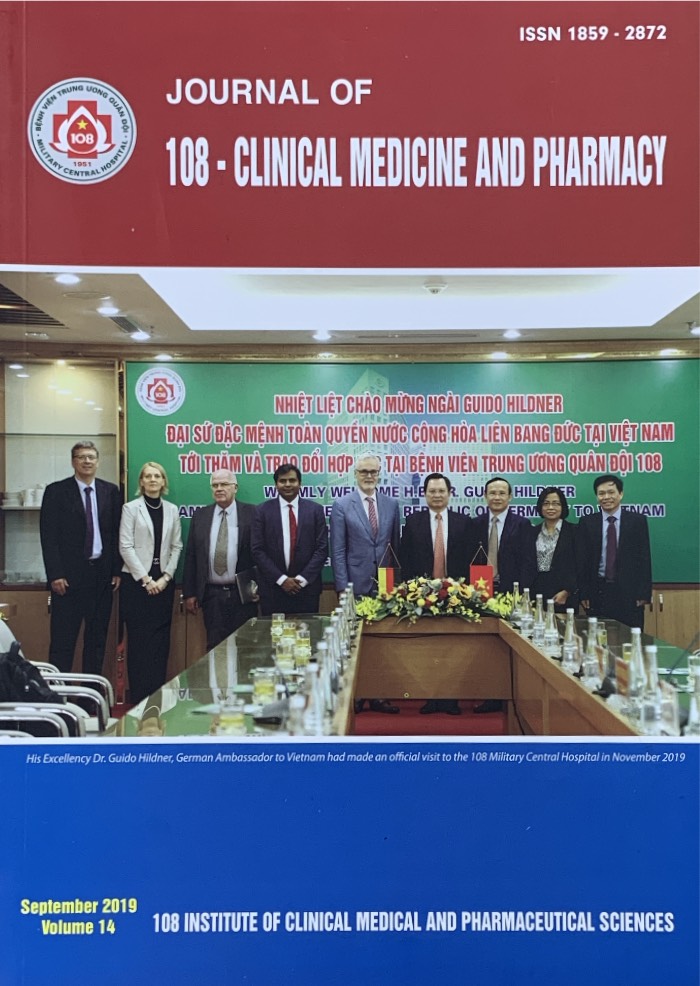The effects of combination therapy with dutasteride and doxazosin clinical outcomes in men with symptomatic benign prostatic hyperplasia
Main Article Content
Keywords
Tóm tắt
Objective: To investigate whether a combination of 0.5mg avodart plus 4mg doxazosin is more effective than 4mg doxazosin alone in treatment‐naïve men with moderately to severe symptomatic benign prostatic hyperplasia (BPH) at risk of progression. Subject and method: This was a multi-centre, randomised, open‐label, parallel‐group study in 100 men with an international prostate symptom score (IPSS) ≥ 8, prostate volume ≥ 30mL and total serum PSA level of < 4ng/mL. Patients were randomised to 0.5mg avodart plus 4mg doxazosin (50 patients) or 4mg doxazosin alone (50) and followed for 6 months. The primary endpoint was symptomatic improvement from baseline to 6 months, measured by the IPSS. Secondary outcomes included BPH clinical progression, impact on quality of life (QoL), and safety. Result: The change in IPSS at 6 months was significantly greater for avodart plus doxazosin than doxazosin alone (-4.68 vs -0.02 points, p<0.05). With avodart plus doxazosin the risk of BPH progression was reduced by 36% (p<0.05), 18% and 12% of men in the doxazosin alone and avodart plus doxazosin groups had clinical progression, respectively, comprising symptomatic progression in most patients. Improvements in QoL (Question 8 of the IPSS) were seen in both groups but were significantly greater with avodart plus doxazosin groups compared with doxazosin alone, -1.46 vs 0.14, respectively (p<0.05). The occurrence of drug‐related AEs, was greater in the combined therapy group. The most commonly reported AEs across both groups were erectile dysfunction and retrograde ejaculation, which occurred in 6% vs 0% and 6% vs 4% patients in the combined therapy and doxazosin alone groups, respectively. Conclusion: The combined therapy with avodart plus doxazosin resulted in rapid and sustained improvements in men with moderate to severe BPH symptoms at risk of progression with significantly greater symptom and QoL improvements and a significantly reduced risk of BPH progression compared with doxazosin alone.
Article Details
Các tài liệu tham khảo
2. Barry MJ, Williford WO, Chang Y et al (1995) Benign prostatic hyperplasia specific health status measures in clinical research: How much change in the American Urological Association symptom index and the benign prostatic hyperplasia impact index is perceptible to patients? J Urol 154: 1770-1774
3. Carballido J, Brenes F, Boye A, Pagliarulo A, Sessa A, Castro R (2012) Baseline characteristics of men diagnosed with benign prostatic hyperplasia following spontaneous reporting of lower urinary tract symptoms to their general practitioner: An analysis of data from the D‐IMPACT (Diagnosis IMprovement in PrimAry Care Trial) study. Eur Urol 11: 98-99.
4. Gratzke C, Bachmann A, Descazeaud A et al (2015) EAU Guidelines on the assessment of non-neurogenic male lower urinary tract symptoms including benign prostatic obstruction. Eur Urol. 67(6): 1099-1109.
5. Kruep EJ, Hogue SL, Eaddy MT, Chandra MD (2011) Clinical and economic impact of early versus delayed 5‐alpha reductase inhibitor therapy in men taking alpha blockers for symptomatic benign prostatic hyperplasia. P T 36: 493-507.
6. McConnell JD, Roehrborn CG, Bautista OM et al (2003) The long‐term effect of doxazosin, finasteride, and combination therapy on the clinical progression of benign prostatic hyperplasia. N Engl J Med 349: 2387-2398.
7. Mebust WK, Holtgrewe HL, Cockett AT, Peters PC (1989) Transurethral prostatectomy: Immediate and postoperative complications. Cooperative study of 13 participating institutions evaluating 3,885 patients. J Urol 141(2): 243-247.
8. Montorsi F, Henkel T, Geboers A et al (2010) Effect of dutasteride, tamsulosin and the combination on patient‐reported quality of life and treatment satisfaction in men with moderate‐to‐severe benign prostatic hyperplasia: 4‐year data from the CombAT study. Int J Clin Pract 64: 1042-1051.
9. Rassweiler J, Teber D, Kuntz R, Hofmann R. (2006) Complications of transurethral resection of the prostate (TURP)-incidence, management, and prevention. Eur Urol 50: 969-980.
10. Roehrborn CG (2008) BPH progression: Concept and key learning from MTOPS, ALTESS, COMBAT, and ALF‐ONE. BJU Int 101(3): 17-21.
11. Roehrborn CG, Siami P, Barkin J et al (2010) The effects of combination therapy with dutasteride and tamsulosin on clinical outcomes in men with symptomatic benign prostatic hyperplasia: 4‐year results from the CombAT study. Eur Urol 57: 123- 131.
12. Roehrborn C, Oyarzabal Perez I, Roos E et al (2015) Efficacy and safety of a fixed-dose combination of dutasteride and tamsulosin treatment (Duodart(®)) compared with watchful waiting with initiation of tamsulosin therapy if symptoms do not improve, both provided with lifestyle advice, in the management of treatment-naïve men with moderately symptomatic benign prostatic hyperplasia: 2-year CONDUCT study results. BJU Int 116: 450-459.
 ISSN: 1859 - 2872
ISSN: 1859 - 2872
